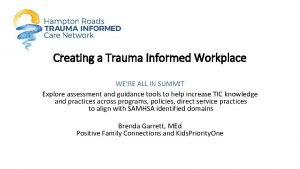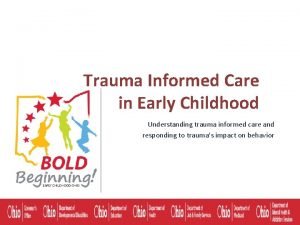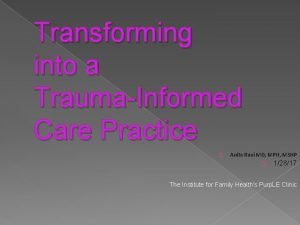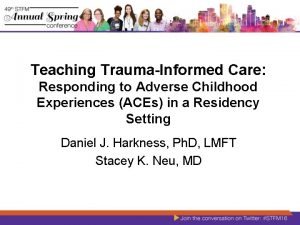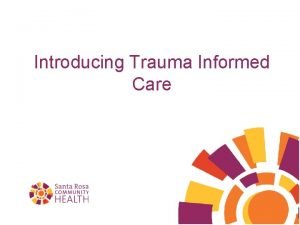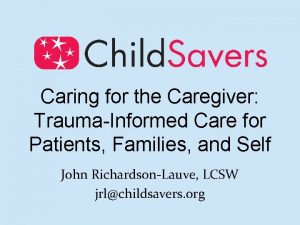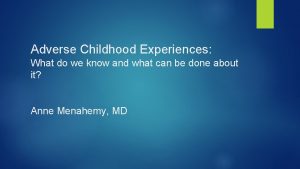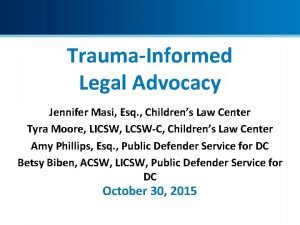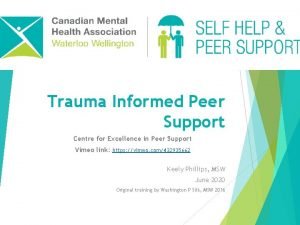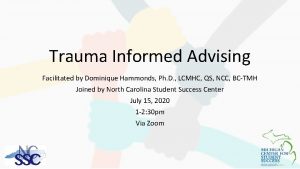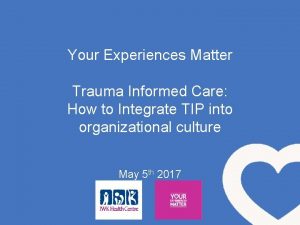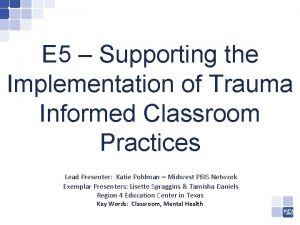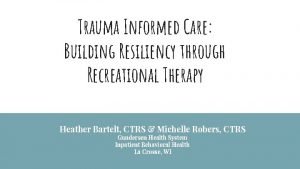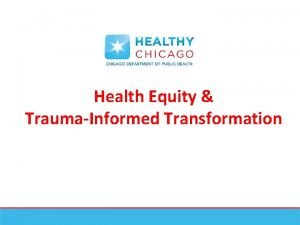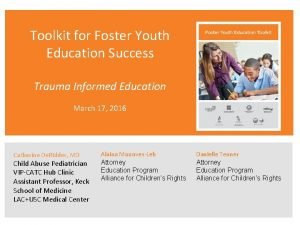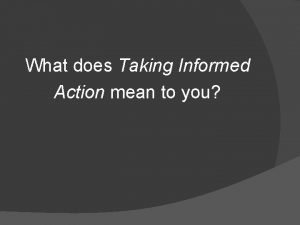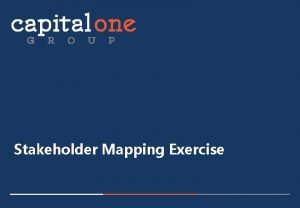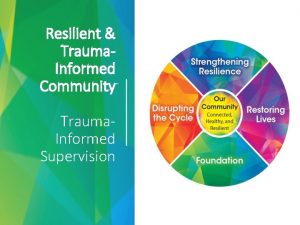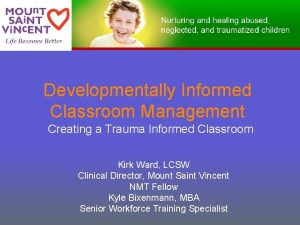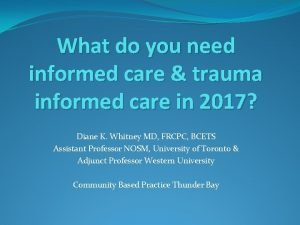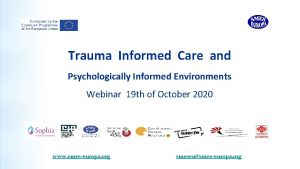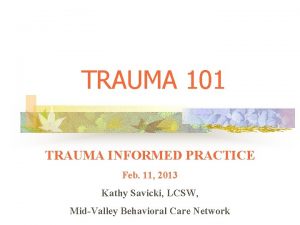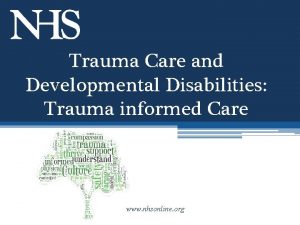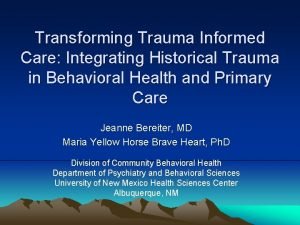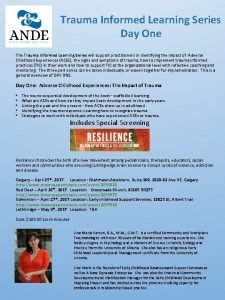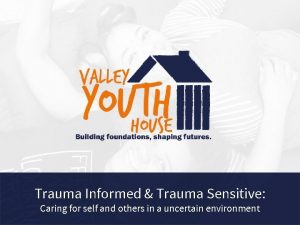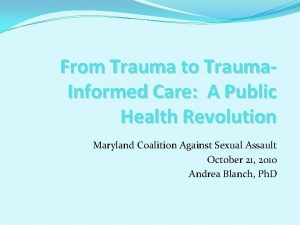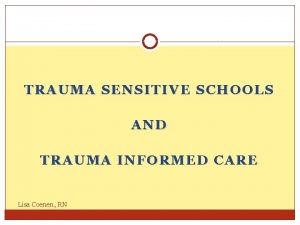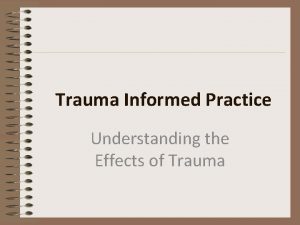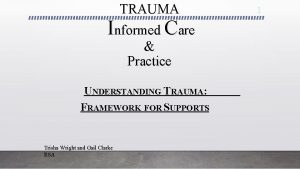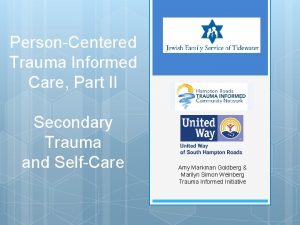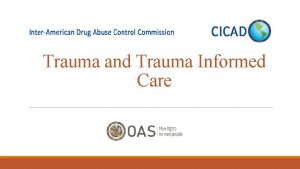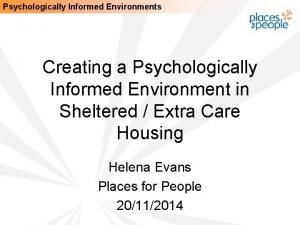Creating a Trauma Informed Workplace WERE ALL IN























- Slides: 23

Creating a Trauma Informed Workplace WE’RE ALL IN SUMMIT Explore assessment and guidance tools to help increase TIC knowledge and practices across programs, policies, direct service practices to align with SAMHSA identified domains Brenda Garrett, MEd Positive Family Connections and Kids. Priority. One

Objectives • Understand how and why Trauma Informed Care has risen to a national public health movement. • Review Drs. Roger Fallot and Maxin Harris’ findings regarding trauma and their call for moving toward a system of services that are “traumainformed. ” • Identify the 6 TI Domains (SAMHSA) • Understand what it means to be “trauma informed” • Explore a variety of tools available for assisting agencies, programs and service systems – and individuals - in becoming trauma informed

The Trauma-Informed Movement • 40+ year of increasing awareness of trauma correlating w/ mental health; and more recently, through the ACE study (1995 -97), an understanding of trauma’s impact on a wide host of health-outcomes over the lifespan. • 1994 – SAMHSA convenes the “Dare to Vision” conference - committing to bring trauma to the foreground – and to call attention to how standard practices in service systems were often traumatizing, and capable of triggering traumarelated memories and reactions. • 1998 – SAMHSA funds “Women, Co-Occurring Disorders, and Violence Study” – leads to better understanding of integrated services approaches for women w/ co-occurring MH/SA and histories of physical and sexual abuse. • After years of debate, the APA identifies a category of Trauma and Stressor. Related Disorders across the life-span in DSM-V

The Trauma-Informed Movement builds… • Understanding the link between childhood experiences of trauma and subsequent MH and SA disorders - SAMHSA creates National Child Traumatic Stress Network. • SAMHSA’s National Center for Trauma-Informed Care and Alternatives to Seclusion and Restraints, finds that “the organizational climate and conditions in which services are provided played a significant role in maximizing the outcomes of interventions and contributing to the healing and recovery of the people being served” (SAMHSA’s Concept of Trauma and Guidance for a Trauma. Informed Approach, 2014).


Reasons for becoming more Trauma Informed… 1. Trauma is pervasive. 2. The impact of trauma is very broad and touches many life domains. 3. The impact of trauma is often deep and life-shaping. 4. Violent trauma is often selfperpetuating. 1. Trauma is insidious and preys particularly on the more vulnerable among us. 2. Trauma affects the way people approach potentially helpful relationships 3. Trauma has often occurred in the service context itself.


What does it mean to be a “Trauma-Informed” organization? Group input/ discussion

What is Trauma Informed Care? • TIC is an approach to engaging people with histories of trauma that recognizes the presence of trauma symptoms and acknowledges the role that trauma has played in their lives. • • National Center for Trauma Informed Care/ NCTIC www. samsha. gov/nctic

SAMHSA: TI Services should reflect these Core Values/ Elements… 1. Safety 2. Trustworthiness & Transparency 3. Peer Support 4. Collaboration and Mutuality 5. Empowerment, Voice/ Choice 6. Cultural, Historical and Gender Identity Sensitivity

Trauma Informed Organizational Self Assessment

How is your organization doing? Complete the first page of the Assessment – “Supporting Staff Development/Training and Education” for ‘Staff at all levels of the program’ [Copies provided]

The Assessment serves as a good checklist across domains of Human Services agency preparedness – Staff development, Safe and Trusted Environment, Assessment & Planning Services, Cultural/Gender Awareness training, Involving Participants, Adapting Policies It is not a How-to Guide.

Fallot – Harris Protocol An in-depth Agency Self-Assessment and Planning Tool Step 1: Examining program settings and activities across the 6 Core Elements (safety, trustworthiness, choice, etc. ) Step 2: Ask Key Questions about EACH of the Activities and Settings Step 3: Prioritize Goals for Change – based on feasibility, resources, system support, breadth of impact, quality of impact, and risks and costs of not changing.

Fallot – Harris Protocol Examining SAFETY Handout and Group Discussion

Additional SAFETY Sample Specific Questions

Fallot – Harris Protocol Examining CHOICE – Maximizing Consumer Choice and Control

Screening for Trauma What is your agency’s practice for screening? Variety of tools available: ACE Questionnaire (10 questions – for adolescents/adults) 35 Assessments Tools reviewed: Assessment and Screening Tools for Trauma in Children and Adolescents A Review Virginia C. Strand, Teresa L. Sarmiento, Lina E. Pasquale First Published January 1, 2005 http: //journals. sagepub. com/doi/abs/10. 1177/1524838004272559

The ACE Study—A great place to start! Dr. Nadine Burke Harris, TED Talk https: //www. ted. com/talks/nadine_burke_harris_how_childhood_trauma_affects_health_across_a_lifetime/discussion? CMP

Where to begin the TIC Agency Journey • HRTICN – has several members you can reach out to for staff development and agency assessment and development support. Fees vary • Look within your own organization for resources for initial training on “what trauma is” and what it means to be “trauma-informed” • Conduct an Agency Assessment • Develop a Multi-dimensional team – clinical, social workers, case managers, admin staff and leadership to review the Assessments and begin steps to move the entire agency forward in your TIC journey. • Understand that the “trauma-informed” transformation is ongoing – with neverending opportunities to learn more and improve your skills in service delivery and program management.

Q&A

Support for Organizations’ adoption of Trauma Informed Approaches Variety of resources & tools available: 1. HRTICN Coalition – The Up Center, lead agency; Andrea Long 2. SAMHSA Website www. samhsa. gov 3. National Child Traumatic Stress Network www. nctsn. org 4. “Trauma-Informed Services: A Self-Assessment and Planning Protocol” – Roger D. Fallot, Ph. D, and Maxine Harris, Ph. D, Community Connections, Washington, DC. 5. ACE Study: https: //www. ajpmonline. org/article/S 07493797(98)00017 -8/pdf 6. Trauma-Informed Organizational Self-Assessment for Child Abuse Prevention Agencies (and others very similar)

Brenda Garrett, MEd Positive Family Connections 757 -291 -2514 positivefamilyconnections@gmail. com www. positivefamilyconnections. com
 Trauma-informed workplace checklist
Trauma-informed workplace checklist 4 r's trauma informed care
4 r's trauma informed care Trauma informed care lgbtq
Trauma informed care lgbtq 4 r's trauma informed care
4 r's trauma informed care Pillars of trauma informed care
Pillars of trauma informed care Trauma informed icebreakers
Trauma informed icebreakers Trauma-informed questions for clients
Trauma-informed questions for clients 4 r's trauma informed care
4 r's trauma informed care Trauma informed legal advocacy
Trauma informed legal advocacy Kobtion
Kobtion Libby bergman
Libby bergman Tina champagne trauma informed care
Tina champagne trauma informed care Trauma informed advising
Trauma informed advising Acessexual
Acessexual Trauma informed practice
Trauma informed practice Trauma infromed
Trauma infromed Trauma informed practice
Trauma informed practice Trauma informed practice
Trauma informed practice Trauma informed care for foster youth
Trauma informed care for foster youth Draw three noncollinear points j k and l
Draw three noncollinear points j k and l Was were going to future in the past
Was were going to future in the past Informed action
Informed action Parents promoters apathetics defenders
Parents promoters apathetics defenders Psychologically informed environment
Psychologically informed environment
